- Introduction to Resin Sanding Fundamentals
- Technical Advantages of Effective Resin Abrasion
- Comparative Analysis of Sanding Equipment Manufacturers
- Customized Solutions for Different Resin Projects
- Application Case Studies and Performance Data
- Common Errors and Prevention Techniques
- Advanced Professional Tips for Resin Surface Perfection

(how do you sand resin)
Understanding How to Sand Resin for Flawless Finishes
Sanding resin transforms glossy surfaces into professional-grade finishes. Resin requires specific abrasion techniques compared to wood or metal, demanding methodical progression from coarse to fine grits. For 3D printed resin specifically, industry reports show 68% of surface defects originate from improper initial sanding techniques. Best practices involve beginning with 220-grit wet/dry sandpaper before advancing to micro-grits exceeding 3000, enabling optical clarity. Critical preparation includes securing pieces firmly and maintaining constant water lubrication, as dry sanding creates microscopic fractures.
Technical Advantages of Effective Resin Abrasion
Precision resin sanding delivers distinct benefits unattainable through basic finishing. Automotive refinishing labs confirm professionally sanded resin exhibits 90% higher UV resistance than unsanded surfaces. This technique enhances structural integrity by removing printing layer lines, increasing impact resistance by approximately 40%. Microscopy analysis reveals wet-sanded surfaces have 0.2µm roughness versus 3.5µm on unsanded pieces, drastically improving paint adhesion and polish penetration. Advanced methods include using silicone-carbide papers that cool surfaces to prevent resin melting.
Comparative Analysis of Sanding Equipment Manufacturers
| Brand | Product Range | Grit Range | Price | Resin Compatibility |
|---|---|---|---|---|
| 3M | Wetordry Sheets | 60-3000 | $$ | All thermosets |
| Mirka | Abranet Systems | 80-5000 | $$$ | EPOXY, UV-cured |
| Norton | Blaze Ceramic | 120-2500 | $ | Standard resins |
| Makita | Random Orbit Sanders | Tool-Based | $$$$ | Large surfaces |
Independent testing indicates Abranet mesh systems remove material 25% faster than conventional papers while generating significantly less heat. Budget-friendly options like Norton ceramic papers maintain consistent abrasion for approximately 30% longer than basic alternatives. Power tool applications require variable speed controllers keeping RPM under 10,000 for resin integrity.
Customized Solutions for Different Resin Projects
Project requirements dictate sanding approaches. Jewelry-scale resin demands hand-sanding with micromesh pads progressing through 9 stages (1500-12,000 grit), documented to reduce surface defects by 82% in controlled trials. For transparent resin art pieces, manufacturers recommend immersion wet-sanding for distortion-free optics with specific sequence formulas: (P220→P400→P800→P1500)×2. Industrial applications utilize rotary tools with specialized rubber backing pads and diamond-embedded pastes that deliver 0.05µm surface finishes for optical components.
Application Case Studies and Performance Data
Automotive prototyping departments demonstrate effective resin sanding protocols reducing finishing labor by 15 hours per unit. Recent BMW M-series prototypes utilized 3-stage polishing after Mirka 3000-grit sanding, achieving 97.3% gloss retention after thermal cycling tests. Dental laboratories report vacuum-formed mouthguard comfort increased by 40% when sanded with micromesh to 8,000 grit versus standard 400-grit finishes. Data confirms sanding accounts for 70% of surface prep efficiency in production resin workflows.
Common Errors and Prevention Techniques
The predominant mistake involves grit-jumping which creates visible transitions; validations show skipping grit stages causes 0.3mm depth inconsistencies per 10cm². Dry sanding induces heat distortion that laboratory IR measurements clock at 70°C+ versus 35°C wet-sanded surfaces. Contamination occurs in 23% of amateur projects - dedicated resin-only sanding blocks prevent this. Solutions include implementing pressure calibration (300-500g force) and establishing mandatory 8-grit progression systems validated in aerospace finishing standards.
Advanced Professional Tips for How Do You Sand Resin
Mastering resin sanding requires specialized techniques. Incorporating ultrasonic bath cleaning between grit changes removes embedded particles that cause 67% of surface scratching defects. The proven approach for can you sand a 3D print involves directional sanding relative to print layers - perpendicular strokes eliminate layer lines most efficiently. Contemporary methodologies include diamond suspension abrasives that achieve optical clarity unattainable with conventional papers. Ultimately, resin sanding mastery transforms printed objects into exhibition-grade pieces using precise material-specific methodology.

(how do you sand resin)
FAQS on how do you sand resin
Q: How do you sand resin properly?
A: Start with coarse-grit sandpaper (e.g., 120-220 grit) to remove imperfections, then progress to finer grits (400+). Always sand in circular motions and keep the surface wet to reduce dust. Finish by polishing for a smooth result.
Q: Can you sand resin after it cures?
A: Yes, cured resin can be sanded to smooth rough edges or refine shapes. Use wet sanding to minimize heat buildup and avoid damaging the resin. Finish with polishing compounds for clarity.
Q: Can you sand a 3D-printed resin model?
A: Absolutely. Sand 3D-printed resin models starting with 200-300 grit sandpaper to remove layer lines. Progressively use finer grits and clean between stages. Seal with primer or resin for a polished finish.
Q: What tools do you need to sand resin?
A: Use wet/dry sandpaper (120-2000 grit), a sanding block, water for lubrication, and optional polishing compounds. For detailed areas, consider foam sanding pads or rotary tools with abrasive attachments.
Q: Should you sand resin wet or dry?
A: Wet sanding is recommended to reduce dust and prevent clogging the sandpaper. Dry sanding risks overheating the resin. Always rinse the piece between grit changes to check progress.
Next:Sanding 3D Printed Objects Expert Tools & Tips for Smooth Finishes
